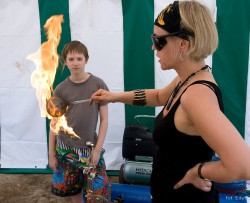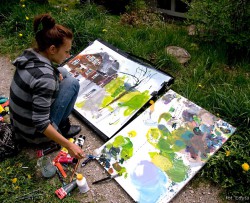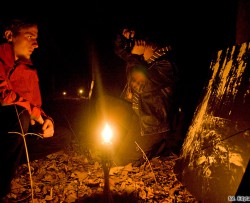Szklarska Poreba, "the Pearl of Karkonosze"
Szklarska Poreba is a holiday and tourist town at the foot of the Karkonosze and the Jizera Mts. It is located on the shortest route between Prague and Wroclaw, not too far away from Saxony or Berlin. The advantageous location among forests on the banks of the Kamienna River, in an area abounding in rich deposits of quartz, resulted in the ongoing development of the manufacture of glass since the Middle Ages. In 1842, a glass factory, "Josephine" /later "Julia"/ has been opened, which became one of the most famous in the world. Szklarska Poreba has become a popular holiday resort, and was dubbed "Pearl of Karkonosze".
At the end of the 19th century people of science, literature and art began coming to Szklarska Poreba. Attracted by the majesty of the mountains, peace and close contact with nature, they chose to break free from the urban bustle. Numerous such exceptional places - art colony – were created in Europe. The most famous is the French Barbizon, German Worpswede, Zakopane, Kazimierz on the Vistula River and Szklarska Poreba.
In 1890, during one of their trips, Carl and Gerhart Hauptmann, fascinated with the sheer beauty of Karkonosze, decided to settle here. After years, Gerhart Hauptmann recalled this event:
"One day while hiking in the mountains, I saw a valley from up high, and thought it would be good to build a house here. Delighted and dazzled by the idea I came down through the woods, ran a path among the meadows, and within a few hours arranged for the purchase of a farmhouse with some land, with a meadow, with a grove and springs."
In Szklarska Poreba Gerhart Hauptmann has created some of his best naturalistic dramas such as "Die Weber" – ‘The Weavers’ "Der Biberpelz" – ‘The Beaver Fur’, or "Hanneles Himmelfahrt" – ‘The Rapture of Hania”. Since 1901, he settled in nearby Jagniątków. In 1912, Gerhart Hauptmann received the Nobel Prize in literature. His older brother Carl Hauptmann remained in Szklarska Poreba. PhD in philosophy and a writer, who described in his works the beauty of the Karkonosze. His most recognized work is the series of legends about the Mountain Spirit - Liczyrzepa – titled "Rübezahlbuch" – ‘The Book of Liczyrzepa’. Carl Hauptmann also made a literary correction to the translation of a novel by Wladysław Reymont's, titled “Chłopi” (‘The Peasants’) into German.
Other well-known writers also lived in the art colony in Szklarska Poreba at the beginning of the 20th century: William Bölsche, Bruno Wille and Hermann Stehr. The economist and sociologist Werner Sombart also visited quite often. Carl Hauptmann shared ties of friendship with a composer Anna Teichmüller, who lived here. Her musical works were performed in major concert halls of Germany. Today these works are almost completely forgotten.
In 1922, the "Künstlervereinigung St. Lukas in Oberschreiberhau" (“St. Luke Artistic Association in Szklarska Poreba”) was established, consisting of twelve artists who settled in the area and took in the Karkonosze landscape painting in Szklarska Poreba in the early 20th century.
Following the end of World War II, Szklarska Poreba began to regain its holiday resort character. The crystal glass factory has resumed its operation, and new residents included Wlastimil Hofman, a well-known painter, who painted in the spirit of symbolism of the Young Poland.
Artists in Szklarska Poreba – present-day art colony
Szklarska Poreba is still a live art colony, inhabited by people of culture and active painters, photographers, sculptors and others, who draw inspiration from the picturesque landscape of our city.
Artists in Szklarska Poreba

Many
of them are members of the New Mill Association, created in the image
and likeness of the Art Association of St. Luke, operating in
Szklarska Poreba in the twenties and thirties of the 20th
century. Our town is where such artists live and work, as Zbigniew
Frączkiewicz - sculptor, creator of the monumental sculptures of
stone and iron, the author of one of the most important sculptural
series carried out in Poland, titled Ironmen (1984), and Beata
Kornicka-Konecka andJanusz Konecki, a creative couple, whose paintings and prints are
known not only in Poland but all over the world.
Szklarska
Poreba artistic environment focuses professional and amateur artists,
some experienced and mature, many others young, fresh, passionate for
the arts. What's important the works of these artists can be seen not
only in exhibitions in the local museum, but also on the city's
postcards (photographs by Zygmund Trylański), in the city ("Ironmen"
Z. Frączkiewicz, the figure of the "Spirit of the Mountains"
by Grzegorz Pawłowski) and even on the tourists trails (stones
with reliefs by Maciej Wokan, which are elements of the Magic Trail
of the Mountain Spirit).
Szklarska Poreba, together with Kazimierz Dolny, are the only Polish art colonies that are members of the EURO-ART European Federation of Art Colonies. www.euroartcities.eu
More on the artists of the New Mill Association – READ
EKOGLASS Festival

In 2008,the activity of glazier artists was reactivated in Szklarska Poreba, through the implementation of specific open-air events, titled EKOGLASS FESTIVAL. A city with a centuries-old tradition of glass manufacture, which coincided with a colony of artists cannot lack events linking these two professions. Ekoglass Festival is a creative meeting of glassworkers and glaziers, during which wonderful and unique pieces of work are made. In addition, the idea of this art event is taking care of the environment, so all forms of glass created during the festival are made by re-melting cullet. The event takes place at Leśna Huta, led Henry Łubkowskiego, master of Karkonosze glass. Every year, the Festival draws ever greater artistic glass makers, not only Polish, but also from the Czech Republic and Slovakia. The event is open to spectators. During the several days of the festival you can see the work of steelworkers and artists working in different techniques.
Open-air art events

Every year open-air crafts events are also held in Szklarska Poreba for young artists - students of Polish universities. For two weeks in the spring (May/June), students come to us from the Wroclaw Academy of Fine Arts: painters, glaziers, sculptors. Under the guidance of college professors: Dr. Piotr Tyszkowski, Dr. Małgorzata Dajewska andDr. Mariusz Łabiński, young artists take part in activities conducted in the town as well as in Leśna Huta, under extra care ofHenryk Łubkowski.

The weekly open-air classes in photography in Szklarska Poreba attract the students of Wroclaw photography schools PHO BOS. In addition to practical classes lectures are also held, as well as photo exhibitions and meetings with known photographers.
For several years now, a sort of ceramic center is created around the guesthouse “Raad na Uroczysku”, where Polish and international open-air activities are organized, as well as workshops for residents and visitors, titled: "Ceramics and you", along with many other activities to promote this field of creativity.
The effects of work of young artists from Wroclaw Academy of Fine Arts, students of PHO BOS and ceramists from the Cracow Academy of Fine Arts can be viewed during the exhibitions held in the House of Carl and Gerhart Hauptmann - Karkonosze Museum in Szklarska Poreba.























